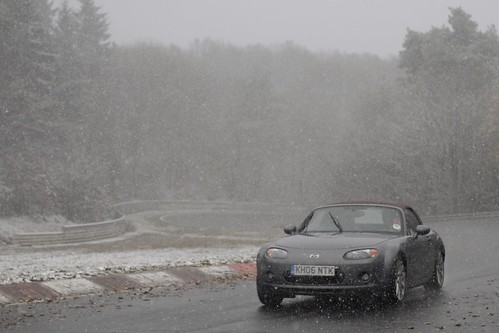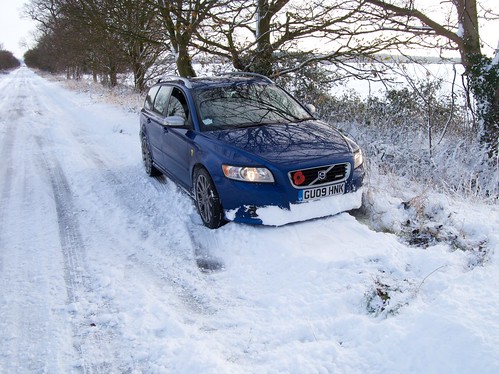I’m writing this on one of the three or four days per year that we get a healthy covering of snow here in the UK, and naturally the news is filled with stories about how there’s chaos on the roads and how we should all be huddled up at home eating canned soup.
Compare this situation to Germany, Sweden or any other country that has regular snow — hell, even Scotland — and by the time you awake in the morning a fleet of snowploughs has cleared all of the roads and life goes on as normal.
Problem Lies Between Steering Wheel and Chair
“We’re not equipped well enough for the snow!” we all cry, blaming the councils for not having enough equipment to clear the roads. Well, yes. Of course they don’t. It snows so rarely in most parts of the UK that it simply isn’t worth investing in the infrastructure required to keep the roads that clear.
The problem is that most drivers in the UK simply don’t know how to deal with snow. Compounded with the typical bullish stubbornness we Brits seem to be famous for, this means most drivers will go out in the snow anyway and cause ton of trouble.
This can be fixed with driver training. I’m fortunate enough to have had a lot of on- and off-track training in various cars over the past few years. This kind of skill is absolutely applicable to driving on the road, especially in snowy, icy or wet conditions. When you’re screaming around a dry race track, you learn to control the car at the very edge of its mechanical grip to eke out every last bit of performance — and if you cross that line, you learn how to control that lack of grip and bring the car back in to check. Now, in the dry you should never be approaching these limits on a public road, but in the ice and snow you will be hitting these limits very quickly.
The best training for this is track driving in the wet. A couple of years ago, exactly that happened, and I ended up spending most of the day being trained to drive a rear-wheel drive car around a wet, snowy Nüburgring as fast as humanly possible. I advanced about six levels of driving skill that day!
Teaching Yourself
Now, I’m the first to admit that driving a sports car around a snowy race track is far from common, so do the next best thing — when it snows, find a safe place to go and play with your car. Today was the first snow day with my current car, so my girlfriend and I went to a local country lane that’s perfect for this — it’s dead straight and has high grass banks on each side so you can bump into them with no damage.
It’s vitally important to know both what to do when you start losing control in the ice and snow, and perhaps more importantly how your own car behaves in these conditions. Why? Well, on modern cars, when ABS kicks in the car makes crunching sounds and the brake pedal starts kicking back at you. When stability control kicks in, it grabs at individual brakes and the steering wheel starts fighting back at you. Experiencing these for the first time when you’re hurtling towards an accident is not the way to experience them for the first time — most people (myself included) instinctively release the brake pedal or steering wheel the first time they feel the car “fighting back”, since it feels like you’re doing damage.
The Three Rules of Correcting a Fishtail
To find out how your car behaves, you first need to know how to make the car stable again.
Stability Control isn't Magic
I’ve heard many people say “Oh, my car has stability control, so I’ll be OK - I can just let go of the steering wheel and it’ll sort itself out.” Unfortunately, traction control is bound by the same laws of physics that everything else is, so this isn’t the case.
The main thing to remember is that stability control helps you maintain stability. If you just let go of the steering wheel, or just hold it straight when you start to lose control, nothing will happen. Stability control helps by helping the car go in the right direction by comparing the direction the car is going (found using accelerometers located throughout the car) to the direction you want it to (found using the angle that the steering wheel is at), and braking individual wheels to get the car pointed in that direction. This leads nicely to…
Always Point the Front Wheels Where You Want To Go
This is a more useful version of the “Turn into a skid” advice. If your car has stability control, this tells it which direction you want to go.
In addition, this helps with mechanical grip. In most situations in snow, the direction you want to go is the direction you’re already going, and keeping the front wheels pointing down the road keeps them in grip, giving you more control. Also, if you suddenly find traction you really don’t want the car suddenly swerving towards oncoming traffic.
For the Love of God, Only Brake In a Straight Line
When your car is breaking free at the rear, the worst possible thing you can do is slam the brakes on. This will cause the front to slow down more than the back, since it has more grip because there’s more weight over it (the engine and the downward force caused by the centre of gravity moving forwards during braking), and the back will try and overtake the front, causing your spin to become much, much worse.
Putting This Into Practice
Now you know the theories behind a how a car behaves, it’s time to practice! Go find that safe place in the snow, and try the following:
Straight Line Braking
Speed up to about 20-25mph, and slam the brakes on. The crunching, pulsing feeling coming through the brake pedal is fine — that’s ABS doing it’s thing. Make note of what your car does during this — it may pull to the left or right, and the feeling through the pedal varies from a light vibration to a heavy pounding depending on the system. In snow, some implementations of ABS are completely useless — if you’re not slowing down, brake more gently to slow the car down without ABS.
Cornering
Next, drive at 20-25mph again and start to turn left then right a little bit, driving in a wavy line. Start very gently with the wheel, increasing the aggressiveness bit by bit until the car starts to break grip. Observe both how much it takes for you to lose grip, and what the stability control does to try and help — as it starts grabbing at the brakes the steering wheel may fight back — it’s important to keep a firm grip. In some cases, the traction control may kick in, limiting the amount of power given to the wheels.
Once you’ve done this, try to get the back end to break free a bit — this can be done by coming off the accelerator just as you’re changing direction in your wavy line — do it enough and the centre of gravity will shift forwards enough for the back end to break loose. Once this happens, remember the rules above: tell the car where you want it to go with the steering wheel, and don’t slam on the brakes. Getting the steering right is a bit of an art — too much or little steering will give too much or little correction. Thankfully, since you’re going slowly in a safe place, you should hit nothing or something soft when you get it wrong.
If your car didn’t break loose: As might be expected, my Volvo stubbornly refuses to do anything remotely exciting in the snow. Time to help it: When you’re changing direction as before, flick up the handbrake briefly to get the back end loose. Remember to let it go — if your rear wheels are locked you won’t be able to do much!
If You're Brave…
Now, if you’re brave, find out what happens when you ignore the above rules — when the back end breaks free, let go of the wheel and slam on the brakes, as you might when panicing. After many successful recoveries using the above rules, when my girlfriend tried to do this, the car immediately left the road and got stuck in the verge, ploughing the snow flat as it went:
Thankfully, my girlfriend and I are both smart enough to know how to get a car unstuck — be patient and be very gentle on the clutch. In this situation, torque is your worst enemy, so start in as high a gear as you can (we were using 2nd and 3rd) and feather the clutch just enough to make the car move. You also want weight over the drive wheels, so if your car is rear-wheel drive, make everyone get in the back.
"Wait, you're saying this is a good idea?"
Many people I know will tell me I’m being irresponsible for doing this myself, let alone telling others to do it. However, I saw one of those people nearly trash £55,000 worth of Porsche by simply letting go of the wheel and hitting the brakes when the back end broke loose, so what the hell do they know?
When you’re dealing with a car that’s losing control, you need to know how the car behaves in order to concentrate on getting it back in check. When you start losing control, you have seconds to react and fix it before you go past the point of no return. If you’re already compensating for your car’s tendency to pull right under heavy braking in the snow by the time it happens and putting in exactly the right amount of steering to stabilise the car and allow stability control to do its job, you have a much better chance of coming out of it without a dented car or skull than someone who’s thinking “Shit, what’s what crunching sound?! Why is my car pulling to the left? Why has my car lost power?”
I do these exercises every year to make sure I’m good enough at controlling the car to allow myself out on the roads in the snow. If you don’t want to do this, I strongly recommend booking a track day and getting some tuition. It doesn’t matter if you’ve never driven on a track before — when you greet your instructor and tell him that you want to learn how to control your car at the limit so you’re safer in the wet and snow you’ll instantly earn genuine respect from him and be better than 95% of everyone else on the road.

